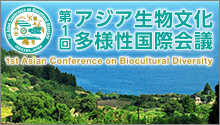On October 16 (Sat), 2021, the first of three seminars for the GIAHS Youth Summit Series was held online. The seminar was hosted by United Nations University’s Institute for the Advanced Study of Sustainability, Ishikawa Kanazawa Operating Unit (UNU-IAS OUIK) and supported by Sado City and the Office for Community Design of the Sado Island Center for Ecological Sustainability, Niigata University. The participants included 40 youths (mainly high school students) who are living in Takachiho in Miyazaki, and the Noto area of Ishikawa prefecture and Sado, Niigata prefecture (which are both celebrating their 10th anniversary of GIAHS designation this year), and 15 people from schools and local government offices.
First, OUIK office manager Ms. Nagai explained the purpose of the Youth Summit. She said that she hopes to work with young people not simply to search for answers, but to create the future GIAHS through various initiatives with the theme of “what are the values of GIAHS?”.
Next, Evonne Yiu from UNU-IAS OUIK gave a lecture titled “Let’s learn about GIAHS”. She gave an overview of GIAHS and introduced its purpose and the regions that have been designated so far. According to Ms. Yiu, GIAHS are attracting attention, since they might provide solutions to global issues such as the SDGs and climate change. Perhaps, the participants were able to recognise previously unknown value and advantages of the regions in which they live.
Subsequently, students from Noto High School in Ishikawa gave a presentation titled “Misa-Noto Project – Peninsular Revolution P.P.”. The project developed through their exchanges with Misaki High School in Ehime, which began since both high Schools are located on peninsulas (Noto Peninsula and Sadamisaki Peninsula). They developed and sold products using agricultural crops from each other’s region to revitalise both regions. In Misaki High School, they made smoothies using blueberries from Noto and plums from Sadamisaki and sold them at local roadside stations. In Noto High School, marmalade and bread using oranges from Ikata-cho of Ehime were made and sold at their school festival. They expressed their hopes for revitalising their regions through joint development and sales of more products.
After that, students of Gokase Secondary School in Miyazaki gave a presentation titled “Miyazaki Prefectural Gokase Secondary School and the Takachihogo-Shiibayama GIAHS site”. They introduced their school as being the first secondary school in Japan, and talked about their class for comprehensive research, called “Searching for Forestopia”. First-year through third-year students (junior high school students) are learning about the Takachiho GIAHS site from various perspectives and fourth-year through sixth-year students are studying their region according to specified themes. They said their region has many unique characteristics which can be utilised to its advantage.
In the latter period of the seminar, a youth-only exchange meeting was held. They were divided into small groups, using the Zoom breakout room function. They exchanged opinions on the topics of “what are you doing in relation to GIAHS, or what activities are you involved in with other people?” and “what do you want to add to GIAHS?”. They looked a little nervous, meeting high school students or university students from other regions for the first time. However, there were some unique opinions: “I also make marmalade. I think it’s wonderful to have exchanges between peninsulas. I hope that our school can do something in collaboration with other regions”, “how about making a character for the GIAHS?” and “why don’t we make a movie about GIAHS?”.
The interesting point of this project is that it does not end today but continues on to the next seminars in series. The second seminar is to be held at the Sado GIAHS site in a hybrid style. In the third seminar (Nov), some people from Sado and Takachiho are scheduled to visit Noto and participate in the Youth Summit in person. The first Youth Summit could be an occasion to create new connections between young people and conceive an idea to start something interesting.



